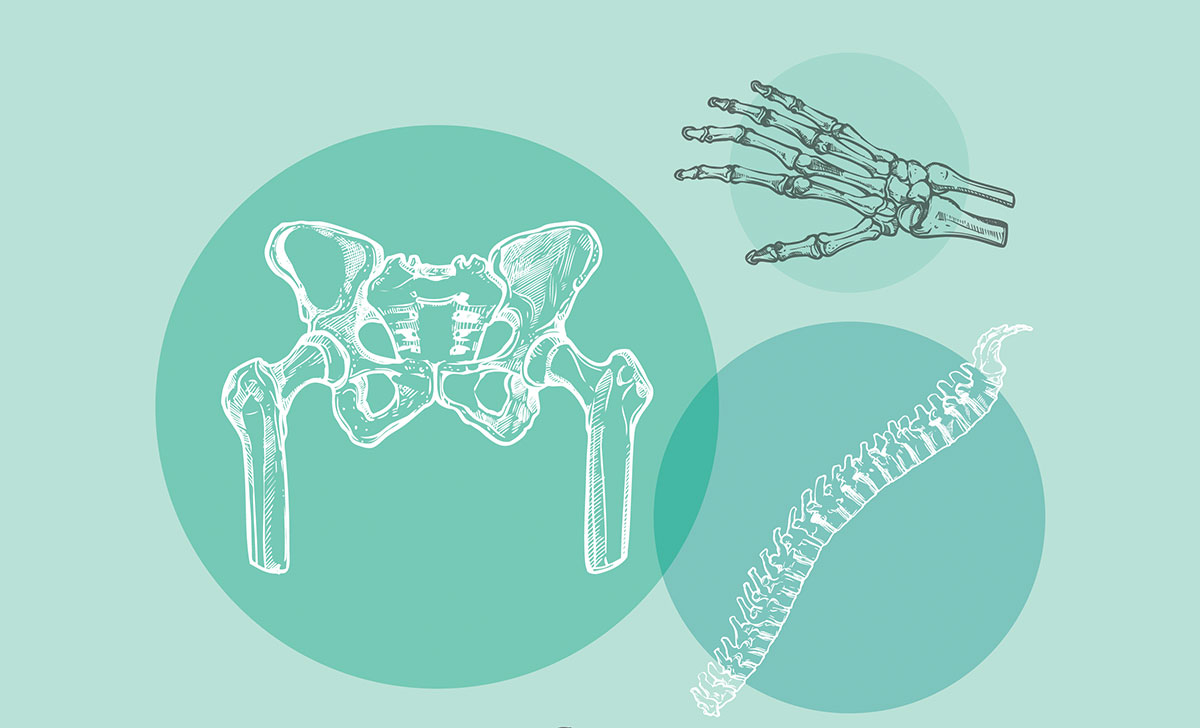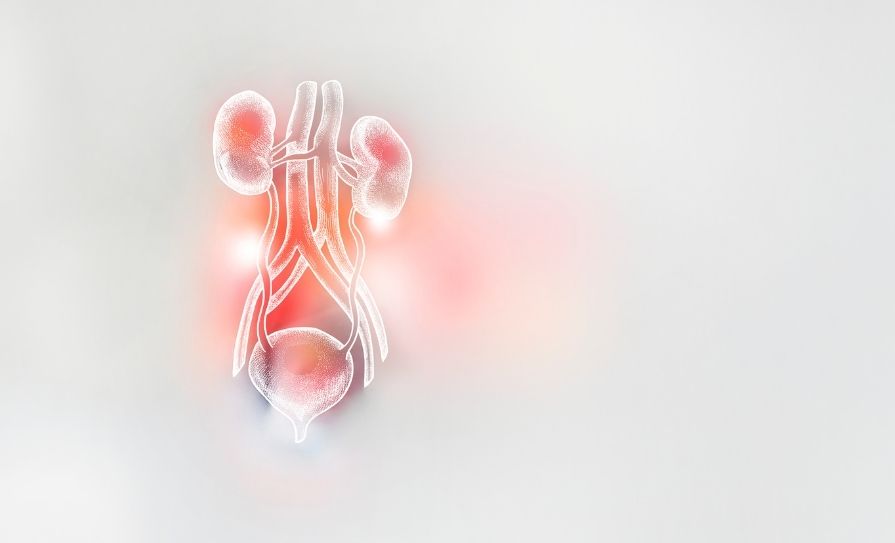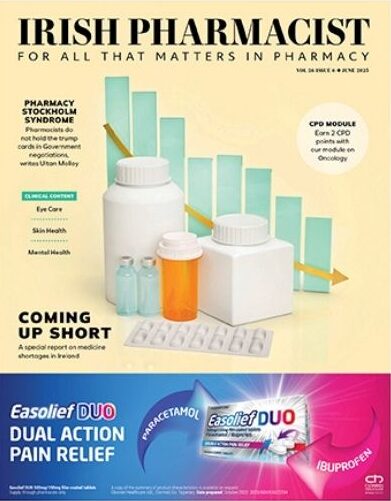A Synopsis Of The Wide Variety Of Risk Factors For Osteoporosis, As Well As Treatment And Management Options.
INTRODUCTION
Osteoporosis is a progressive bone disease characterised by low bone mass, microarchitectural deterioration of bone, and compromised bone strength, increasing fracture risk.1,2 One-in-four men and one-in-two women aged over 50 will develop a fracture due to bone fragility in their lifetime. Women with osteoporosis are more commonly at risk of vertebral fractures, whereas men are more prone to hip fractures. When caught early, these can be prevented. Some 300,000 people in Ireland are estimated to have osteoporosis, but only 15 per cent are actually diagnosed with bone loss, leaving 280,000 undiagnosed.3 Less than 50 per cent of people can live independently after hip fractures, and over 25 per cent die within 12 months of the fracture.2 Osteoporosis can also affect children.3
Reduction in bone mineral density (BMD) is the cause of increased bone fragility and fractures.1 The risk of fracture increases by about two-fold for each standard deviation (SD) decrease in BMD.2 A BMD score that is between 1-to-2.5 SDs less than the average young adult mean value (ie, a T score between -1 and -2.5) is classified as osteopaenia. A BMD score that is 2.5 less than the average young adult mean value (ie, T score ?-2.5) is defined as osteoporosis. ‘Severe’ or ‘established’ osteoporosis is osteoporosis as defined as a T score ?-2.5 along with one or more documented fragility fractures. Osteoporosis is a ‘silent’ disease, because typically there are no symptoms until a bone fracture occurs. The most common fracture sites are the hip, vertebrae and wrist, although they can occur in any bone.4
RISK FACTORS AND PREVENTION
Osteoporosis risk factors include:2,4
- Sex: It is more common in women. Men (over 70) are also at risk.
- Increasing age is associated with increased bone loss and reduced bone growth.
- Body size: Slender, small-boned women and men are at greater risk, as they have less bone mass to lose.
- Race: White and Asian women and white men are at highest risk.
- Positive family history increases risk of development.
- Hormonal changes: Low oestrogen levels in women and low testosterone levels in men.
- Diet: Low intake of vitamin D and calcium, extreme dieting or low protein intake.
- Medical conditions, ie, endocrine disorders, hormonal diseases, gastrointestinal diseases, rheumatoid arthritis, certain cancers, HIV/AIDS, anorexia nervosa.
- Medications: Glucocorticoids, antiepileptics, cancer treatments, PPIs, SSRIs, and thiazolidinediones.
- Physical activity: Low levels not only contribute to an increased rate of bone loss, but impact strength and fitness, possibly predisposing to an increased risk of falls.
- Alcohol intake should be ?2 units/day.
- Smoking increases risk.
Ideally, adequate calcium intake would be achieved through diet alone, but supplementation is frequently needed to reach the recommended daily dose.2 Supplementation can, however, lead to risks of nephrolithiasis and gastrointestinal disturbances. A daily dose of 400IU vitamin D has been recommended for all adults by the Scientific Advisory Committee on Nutrition (SACN), except in postmenopausal women and men >50 at risk of fracture, a daily dose of 800IU is advised.
The most common fracture sites are the hip, vertebrae and wrist, although they can occur in any bone
Good dietary sources of calcium include:4
- Low-fat dairy products.
- Dark green leafy vegetables, such as bok choy, collards, and turnip greens.
- Broccoli.
- Sardines and salmon with bones.
- Calcium-fortified foods such as soy milk, tofu, orange juice, cereals, and breads.
OSTEOPOROSIS DEVELOPMENT
Our bones are constantly undergoing remodelling, which is a fundamental process for bone renewal. It allows bones to adapt to physical stress, and to repair damaged bone. About 5-to-10 per cent of the skeleton is replaced each year in this process.5,6 The mechanism behind this involves osteoclasts and osteoblasts: Osteoclasts are responsible for bone resorption, removing bone mineral and organic matrix, while osteoblasts lay down new bone matrix. Osteoclast formation and activity is promoted by a wide range of factors, including cytokines, hormones, growth factors, and free radicals. In osteoporosis, there is an imbalance between resorption and formation, resulting in deterioration of bone integrity. A range of biological processes interfere with this resorptive/catabolic balance, including inflammation, metabolic and endocrine disorders, cancers, and ageing.7
DIAGNOSIS
According to NICE guidelines,8 all women aged 65 years and over, and all men aged 75 years and over, are suitable for fracture risk assessment. People younger than this can also be considered if any of the following are present:
- Previous fragility fracture.
- Current or frequent recent use of glucocorticoids.
- History of falls.
- Family history of hip fracture.
- Low BMI (less than 18.5 kg/m2).
- Smoking.
- Alcohol intake >14 units per week for women and >21 units per week for men.
A dual-energy x-ray absorptiometry (DXA) scan of the spine and hips is the gold standard for diagnosing osteoporosis.1 Other risk factors besides BMD should also be taken into account when assessing fracture risk: Many fragility fractures occur in individuals who are not defined as osteoporotic based on the T score definition alone.
TREATMENT
Pharmacological treatments of osteoporosis can target osteoclast-mediated bone resorption, ie, antiresorptive treatments, or stimulating osteoblasts to form new bone, ie, anabolic treatments.9 Calcium and vitamin D supplementation is recommended in all people with osteopaenia and osteoporosis, not only due to their effect on the development of the disease, but also because the clinical trials of pharmacological treatments were performed in populations with adequate calcium and vitamin D levels.10,11
BISPHOSPHONATES
Bisphosphonates inhibit osteoclast-mediated bone resorption due to inhibition of the enzyme farnesyl pyrophosphate synthase.10 The result improves bone mass and microarchitecture, reducing fracture risk as early as six months after therapy initiation.11 Bisphosphonates are indicated in the following circumstances:
- Alendronate: Treatment of postmenopausal osteoporosis; reduces the risk of vertebral and hip fractures.
- Ibandronate: Treatment of osteoporosis in postmenopausal women at increased risk of fracture — reduction in the risk of vertebral fractures has been demonstrated, with efficacy on femoral neck fractures not established.
- Risedronate: Treatment of postmenopausal osteoporosis, to reduce the risk of vertebral and hip fractures, and to treat osteoporosis in men at high risk of fractures.
- Zoledronic acid (injectable): Treatment of osteoporosis in post-menopausal women and in adult men at increased risk of fracture, and treatment of osteoporosis associated with long-term systemic glucocorticoid therapy in the same groups. It is also used to treat Paget’s disease of the bone in adults.
Bisphosphonate treatment is associated with 40-to-70 per cent reductions in vertebral fractures and 40-to-50 per cent reductions in hip fractures; however, use may be limited by side-effects such as atypical femur fractures, and osteonecrosis of the jaw (with an estimated incidence of 0.001–0.01%: More likely with long-term use). Examination by a dentist prior to initiation on these medications is recommended. All patients should report any oral symptoms (mobility, pain or swelling issues), or ear symptoms, ie, chronic ear infections. All thigh, hip or groin pain, which might be indicative of an atypical femur fracture, should also be reported. The oral formulations are also contraindicated in the presence of any oesophageal abnormality that might delay oesophageal emptying, and used with caution in the presence of upper gastrointestinal disorders.
No head-to-head clinical trials have compared bisphosphonate efficacy, so we do not know if one is superior to the others. Alendronate is commonly used as first-line bisphosphonate treatment, however, as there is evidence showing residual fracture benefit in selected patients after completing a five-year course of therapy.12 A review of treatment should be conducted after three (zoledronic acid) or five (alendronate, ibandronate and risedronate) years.
DENOSUMAB
Denosumab is a humanised monoclonal antibody against receptor activator of nuclear factor-?? (RANKL), which regulates the development and activity of osteoclasts. Denosumab inhibits bone resorption, decreasing the differentiation of osteoclasts.9 This is licensed for the treatment of osteoporosis in postmenopausal women and in men at increased risk of fractures, treatment of bone loss associated with hormone ablation in men with prostate cancer, and also bone loss associated with long-term systemic glucocorticoid therapy.
It significantly reduces the risk of vertebral, non-vertebral and hip fractures. Denosumab is administered six-monthly as a 60mg subcutaneous injection. Hypocalcaemia is a risk in patients treated with this drug. Monitoring of calcium levels should be performed prior to administration, and, in patients predisposed to hypocalcaemia, two weeks after the initial dose. As with bisphosphonates, osteonecrosis of the jaw and atypical femoral fractures have also been reported, so similar advice regarding monitoring for these symptoms should be given to the patient. When treatment with denosumab is stopped, rapid bone loss occurs.
TERIPARATIDE
Intermittent activation of the parathyroid receptor type 1 by short pulses of parathyroid hormone (PTH) results in anabolic effects on bone. Teriparatide is a recombinant human PTH with these anabolic effects, used for treatment of osteoporosis in postmenopausal women and men. A significant reduction in the incidence of vertebral and non-vertebral fractures (reduction of 80 per cent and 28 per cent respectively), but not hip fractures, has been demonstrated.11
HRT
Some HRT products are approved for the prevention of osteoporosis, mainly in younger postmenopausal women. Oestrogen has direct effects on osteocytes, leading to inhibition of bone resorption and maintenance of bone formation.10 Due to potential side-effects from HRT, like venous thromboembolism, stroke and breast cancer, HRT should be prescribed at the lowest effective dose for the shortest duration and only where appropriate.13 It is only the oral HRT preparations that increase the risk of the side-effects mentioned above. Any potential increased risk in breast cancer is related to treatment duration, and reduces after stopping HRT again.14 In addition to reduction of fracture risk, there is limited evidence that HRT may improve strength and muscle mass.
RALOXIFENE
Raloxifene, a selective oestrogen receptor modulator, is indicated for the treatment and prevention of osteoporosis in postmenopausal women.12 A significant reduction in the incidence of vertebral, but not hip fractures, has been demonstrated.
TESTOSTERONE TREATMENT
In men, testosterone treatment can be useful when osteoporosis is caused by low levels of male sex hormones.15
COMPARISON OF TREATMENTS
Using these medications led to reductions of 30-to-70 per cent in vertebral fracture, up to 20 per cent for non-vertebral fracture, and up to 40 per cent reduction in hip fracture.16 No clinical trial has yet been performed to compare treatments and ascertain which is the most effective. When choosing a drug, the fracture sites protected by the drug, the side-effects, and the cost should be considered.
LIVING WITH OSTEOPOROSIS
Preventing fractures is important due to the negative consequences, such as reduced independence and increased risk of mortality associated with these.4 The following contribute to fall risk:
- Reduced strength and muscle mass.
- Medical conditions impairing mental/ physical functioning, ie, low blood pressure, dementia.
- Polypharmacy (four or more medications).
- Poor vision.
- Poor balance.
- Disorders that affect mobility.
- Alcohol use.
- Side-effects of medications, ie, sedatives or tranquillisers, sleeping pills, antidepressants, anticonvulsants, muscle relaxants, antihypertensives, diuretics.
Donna Cosgrove graduated with a BSc in Pharmacy from the Royal College of Surgeons in Ireland. She then returned to university to complete a MSc in Neuropharmacology, which led to a PhD and further research investigating the genetics of schizophrenia. Over the years Donna has worked in hospital, research and community pharmacy settings, but currently works as a community pharmacist in Galway and as a clinical writer.
References
1. Irish Osteoporosis Society (2011). Osteoporosis Guidelines for Health Professionals. Retrieved from https:// www.icgp-education.ie/osteoporosis/ Osteoporosis-Soc-Guidelines-2011.pdf.
2. Compston J, Cooper A, Cooper C, Gittoes N, Gregson C, Harvey N, & Reid DM (2017). UK Clinical Guideline for the Prevention and Treatment of Osteoporosis. Archives of Osteoporosis, 12(1), 43.
3. Irish Osteoporosis Society (2018). About Osteoporosis. Retrieved from https://www.irishosteoporosis.ie/ about-osteoporosis/.
4. NIH National Institute of Arthritis and Musculoskeletal and Skin Diseases. Health Topics: Osteoporosis In Depth. Available https://www.bones.nih.gov/ health-info/bone/osteoporosis/overview.
5. Appelman-Dijkstra NM, & Papapoulos SE (2015). Modulating Bone Resorption and Bone Rormation in Opposite Directions in the Treatment of Postmenopausal Osteoporosis. Drugs, 75(10),1049-1058.
6. Sims NA, & Martin TJ (2014). Coupling the Activities of Bone Formation and Resorption: A Multitude of Signals Within the Basic Multicellular Unit. BoneKEy Reports, 3.
7. Boyce BF, Li J, Xing L, & Yao Z (2018). Bone Remodeling and the Role of TRAF3 in Osteoclastic Bone Resorption. Frontiers in Immunology, 9.
8. National Institute for Health and Care Excellence. (2017). Bisphosphonates for Treating Osteoporosis (TA464). Available https://www.nice.org. uk/guidance/ta464/resources/ bisphosphonates-for-treating-osteoporosis-pdf-82604905556677.
9. Black DM, & Rosen CJ (2016). Postmenopausal osteoporosis. New England Journal of Medicine, 374(3), 254-262.
10. Maraka S, & Kennel KA (2015). Bisphosphonates for the prevention and treatment of osteoporosis. BMJ 351, h3783.
11. Khosla S, & Hofbauer LC (2017). Osteoporosis Treatment: Recent Developments and Ongoing Challenges. The Lancet Diabetes & Endocrinology, 5(11), 898-907.
12. Black DM, Schwartz AV, Ensrud KE, Cauley JA, Levis S, Quandt SA, … & FLEX Research Group (2006). Effects of Continuing or Stopping Alendronate after 5 Years of Treatment: the Fracture Intervention Trial Long-term Extension (FLEX): A Randomized Trial. JAMA, 296(24), 2927-2938.
13. Pfizer Medical Information (2018). PROVERA (medroxy progesterone acetate). Retrieved from https://www.pfizermedical information.com/en-us/provera.
14. National Institute for Health and Care Excellence (2019). Menopause: Diagnosis and Management. Clinical guideline (NG23). Available https://www.nice.org.uk/guidance/ ng23/resources/menopause-pdf-718895758021.
15. National Health Service (2019). Osteoporosis Treatment. Available https://www.nhs.uk/conditions/ osteoporosis/treatment/.
16. Sacco SM, & Ward WE (2010). Revisiting estrogen: Efficacy and safety for postmenopausal bone health. Journal of Osteoporosis, 2010.







